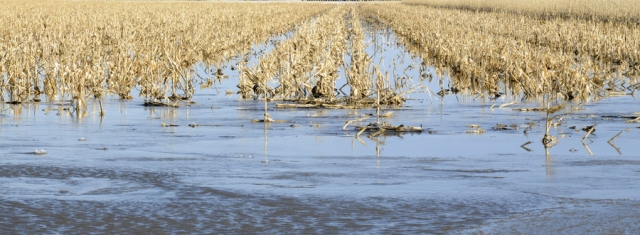Politics
Finance, fuel and fertilizer: the insoluble equation of American farming
US Farmers in trouble

illustrative picture (Source: https://www.goodfreephotos.com/albums/united-state)
USPA NEWS -
The face of American grain farming has changed radically over the last 40 years, largely due to government policy, with big farms now dominating output. “Get big or get out,” former secretary of agriculture Earl Butz famously said in the 1970s. Seeking to boost efficiency in order to cope with greater acreage, farmers have taken on more and more debt at a time when shrinking margins on field crops and global economic forces are making this equation increasingly untenable.
According to a report by the United States Department of Agriculture’s Economic Research Service, although the size of the average farm has remained fairly stable, structural change to the farming industry has led to the disappearance of mid-size farms at the expense of very small and very large farms. These large farms now produce the majority of food for the US market, and in order to remain competitive, farmers have had to specialize, enabling them to rationalize their purchasing and buy more equipment.
This trend towards “gigantism” in farming, requiring larger, ever more sophisticated machinery, has also led to a proportional increase in debt levels, which have nearly doubled among US farmers since the early 2000s. Structural economic forces have been squeezing farmers’ profit margins for years, and although the ten-year trend for energy prices is down, crude oil prices have almost quadrupled since 2019, having a knock-on effect on the cost of running highly mechanized modern farms, leading to growing concerns that farmers’ rising overheads could see a spate of foreclosures like those seen in the 1980s when inflation-adjusted debt levels were equally high.
The outlook for small farmers is particularly grim. “Consolidation in the agricultural industry is making it too hard for small family farms to survive,” conceded President Joe Biden in a recent executive order; if it wasn’t for government subsidies most American corn growers would already be making a loss, and this reality has a terrible psychological impact in and of itself with the suicide rate among farmers higher than that of any other profession. “Farming has always been a stressful occupation because many factors that affect agricultural production are beyond the control of producers,” explains Iowa farmer and psychologist Mike Rosmann. But the indignity of having to sell the fruit of your hard labor at a loss is particularly galling and, contrary to other areas of the economy, when a family farm fails there is often the added guilt and sorrow of letting a family’s treasured heritage slip away. “You feel like you’re the one who is losing the legacy that your great-grandparents started,” said Wisconsin dairy farmer Randy Roecker.
The situation has come to a head in 2021 due to a combination of factors: the price of natural gas, which is the main source of power for nitrogenous fertilizer plants, has reached an eight-year high; China has restricted fertilizer exports to preserve its interior market, which will have a domino effect on global supply leading to worldwide shortages and increased prices; the international community has imposed sanctions on a major Belarus state-owned potash producer; and finally, the US International Trade Centre has decided to impose tariffs of up to 47% on the importation of phosphate fertilizer from Morocco and Russia. The President of the American Soybean Association, Kevin Scott, has railed against these tariffs, highlighting the likely negative impact they will have on the agricultural sector; "We believe duties on these imports will have a negative impact on the availability of phosphate fertilizer in the United States and, in turn, adversely affect crop production and farmer livelihood," he said. “Another year of shortages and tariffs will be devastating,” agreed the President of the National Corn Growers Association, Chris Edington.
This isn’t the only obstacle for embattled American farmers, with logistics disruptions and labor shortages caused by the pandemic also having a knock-on effect on tense glyphosate supply – a context made worse notably by hurricane Ida hitting Bayer’s plant in Louisiana, causing it to shut down for five weeks.
The combination of rising input prices and shortages could make it increasingly difficult for grain farmers to make ends meet in 2022. Faced with a choice of losing money on their harvest, many farmers will turn to other crops. "At the current prices for nitrogen, it's making me take a hard look at my corn acres," said Kentucky-based corn and soybean farmer, Caleb Ragland. "It makes me think we might grow soybeans on some of those acres." Others may be forced to let the land lie fallow or simply sell up.
The result of all this would be food inflation. It is estimated that the duties on fertilizer imports alone would increase grain prices by more than $80 per ton, which would have disastrous consequences for millions of Americans who live close to or under the poverty line and are already suffering from a generalized increase in the cost of living due to the pandemic. Moreover, among concerns that climate change may reverse recent improvements to crop yields and further undermine the competitiveness of American agriculture – and with small, local farms increasingly becoming unviable – there is real unease about potential food shortages. Mechanization and agronomic innovation have consistently enabled farmers to increase crop yields year-on-year in the post-war period; in conjunction with state subsidies, this has masked the structural weakness of US farming, but the current situation lays bare the fragility of American food sovereignty.
Liability for this article lies with the author, who also holds the copyright. Editorial content from USPA may be quoted on other websites as long as the quote comprises no more than 5% of the entire text, is marked as such and the source is named (via hyperlink).






